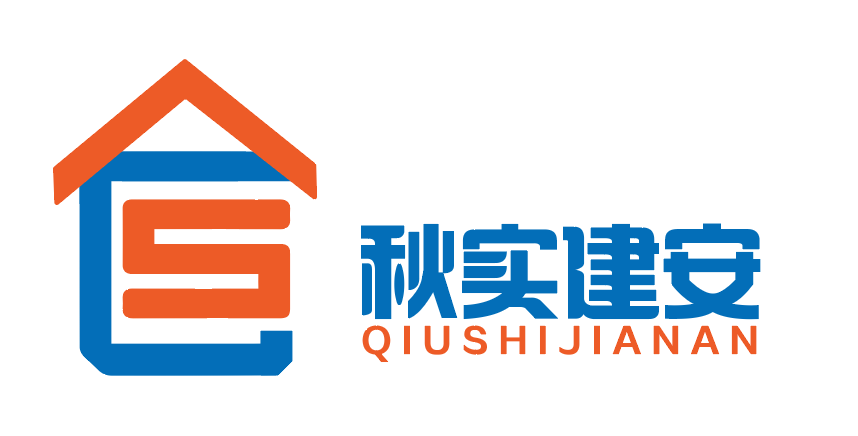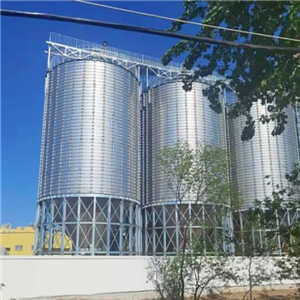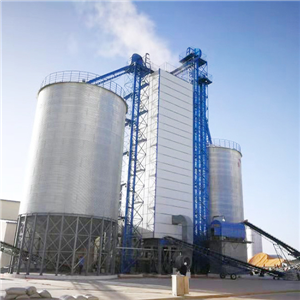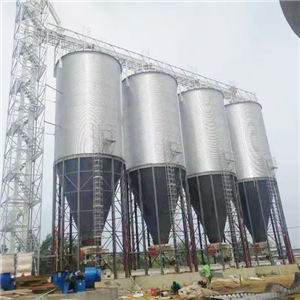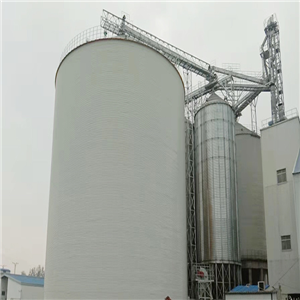Spiral Silos: Transforming the Landscape of Bulk Storage
13-10-2025
Space - Saving Design
When it comes to large - scale storage, spiral silos offer a series of unique advantages, with their space - saving design being one of the most prominent. Thanks to their innovative structure, spiral silos can make the most of vertical space, significantly reducing the footprint required for storage. For example, the Liaoning Qiushi Construction and Installation Engineering Company has long recognized this advantage, especially during the development of large - scale warehousing complexes. By using spiral silos, they were able to stack materials in a more efficient manner, fitting more inventory into the same amount of land area compared to traditional storage methods. This not only optimizes the use of expensive real estate but also allows for better organization within the storage facility.
Durability and Stability
Durability and stability are also key strengths of spiral silos. The Liaoning Qiushi Silo Equipment Engineering Co., Ltd. often updates its website with information about new materials that enhance the silos' resistance to external forces. These new materials, such as high - strength steel alloys and advanced composite materials, make the silos more resistant to corrosion, extreme weather conditions, and mechanical stress. A spiral silo built with these advanced materials can withstand years of use, reducing the need for frequent replacements and maintenance. This long - term durability not only ensures the safety of stored goods but also provides a more cost - effective storage solution in the long run.
Superior Ventilation
Proper ventilation is crucial for storing grains and other agricultural products, and spiral silos are designed with this in mind. Their unique construction allows for better air circulation, which helps maintain the quality of stored items. Good ventilation can prevent issues such as mold growth, spoilage, and overheating, all of which can lead to significant losses for businesses. In contrast, poor ventilation can quickly turn a storage of valuable agricultural products into a liability. Spiral silos, with their optimized ventilation systems, ensure that air can flow freely around the stored materials, removing excess moisture and heat, and thus preserving the integrity of the goods for longer periods.
Practical Application
Site Analysis and Preparation
Despite the obvious advantages, the implementation of spiral silo technologies requires meticulous preparation. Before the installation of a spiral silo, a detailed analysis of the site characteristics and production needs is essential. The Liaoning Qiushi Company once encountered a situation where the selected site was unsuitable due to the characteristics of the soil. This incident served as a valuable lesson, highlighting the importance of comprehensive site surveys. Such surveys should include assessing the bearing capacity of the soil, the topography of the land, and its proximity to production areas and transportation routes. Understanding the production needs, such as the volume of goods to be stored, the frequency of access, and the specific environmental requirements for the stored items, is equally crucial. Only by conducting a thorough pre - installation analysis can the long - term functionality and efficiency of the spiral silo be ensured.
Specialized Equipment and Skilled Specialists
The installation process of spiral silos involves the use of specialized equipment, which demands the expertise of qualified specialists. Specialized lifting equipment, precision measuring tools, and unique construction machinery are often required to assemble the silos accurately. For example, high - capacity cranes are used to lift and position the large components of the spiral silos, and advanced laser - guided alignment tools ensure that the silo sections are precisely aligned. However, this aspect is often overlooked. Without the correct use of specialized equipment and the skills of trained technicians, the installation may result in misaligned components, weak structural integrity, and potential safety hazards. Inadequate installation can also lead to issues such as air leakage in the silo, which can be detrimental to the quality of stored products, especially in the case of storing grains and other perishable goods. Therefore, companies must invest in proper equipment and hire or train skilled personnel to handle the installation of spiral silos to achieve optimal results.
Design Process
Comprehensive Design Considerations
The design of spiral silos is not just a simple planning stage but a complex process that involves multiple aspects. Material selection is a crucial part of it. For instance, choosing high - quality steel with specific strength and durability characteristics can ensure the long - term stability of the silo. Liaoning Qiushi adheres to strict quality standards during this process. They thoroughly research different materials in the market, considering factors such as cost - effectiveness, availability, and compatibility with the overall design.
Load calculation is another essential element. Engineers need to accurately calculate the weight of the stored materials, the dynamic loads caused by filling and emptying operations, and the static loads from the structure itself. This requires in - depth knowledge of engineering mechanics and structural analysis. Any miscalculation in load assessment could lead to structural failures, endangering the safety of the stored goods and the entire storage facility.
Risk assessment is also integrated into the design process. Potential risks, such as natural disasters like earthquakes and floods, as well as man - made risks like improper operation, are carefully evaluated. By identifying these risks in advance, appropriate preventive measures can be designed into the silo, such as strengthening the foundation to resist seismic forces or installing safety - interlock systems to prevent incorrect operation.
The Use of New Anti - Corrosion Coatings
One remarkable development in spiral silo design is the application of new anti - corrosion coatings. These coatings play a vital role in prolonging the service life of the silos. Traditional coatings might only offer limited protection against corrosion, but new anti - corrosion coatings can provide more comprehensive and long - lasting protection.
These advanced coatings are the result of new developments in chemical engineering. Scientists have been researching and developing new chemical compounds and formulations to create coatings with enhanced corrosion - resistance properties. For example, some new coatings contain nanoparticles that can fill in the microscopic pores on the metal surface of the silo, forming a more impermeable barrier against corrosive substances such as moisture, acids, and alkalis.
The use of these new anti - corrosion coatings not only reduces the frequency of maintenance and replacement but also ensures the integrity of the silo structure over a longer period. This, in turn, provides a more stable and reliable storage environment for goods, contributing to the overall efficiency and cost - effectiveness of the storage operation.
Impact on Logistics
Cost - Efficiency in Logistics
One often - overlooked aspect is the impact of spiral silos on logistics processes. The compactness and high - capacity nature of spiral silos can significantly reduce costs associated with the movement and storage of products. For example, in one project, a company achieved a remarkable 15% reduction in operating costs. This cost - saving was made possible by optimizing the logistics chain. The use of spiral silos allowed for a more efficient storage layout, minimizing the need for excessive transportation within the storage facility. With goods stored more densely and in a more organized manner, the frequency of moving products around the warehouse decreased. This, in turn, reduced the fuel consumption of forklifts and other transportation equipment, as well as the wear and tear on these machines. Fewer labor - hours were also required for handling and transporting goods, leading to overall cost savings in labor expenses.Spiral SiloSpiral SiloSpiral SiloSpiral Silo.Spiral SiloSpiral SiloSpiral SiloSpiral Silo.Spiral SiloSpiral SiloSpiral SiloSpiral Silo
Optimization of Intra - complex Transportation
Spiral silos also contribute to the optimization of short - distance transportation of products within the warehousing complex. Their design allows for a more streamlined flow of goods. For instance, materials can be stored closer to the areas where they are most likely to be accessed, whether it's for further processing or for loading onto trucks for distribution. This reduces the distance that products need to be transported within the complex. In a large - scale warehousing operation, even a small reduction in the average transportation distance per unit of product can result in significant savings over time. It not only cuts down on transportation costs but also improves the overall speed and efficiency of the logistics process. Faster access to stored goods means quicker order fulfillment, which can enhance customer satisfaction and give the company a competitive edge in the market.
The Future of Spiral Silos
Integration with New Technologies
In the future, spiral silos are expected to be actively integrated with emerging technologies such as the Internet of Things (IoT) and automated management systems. This technological convergence holds great promise for enhancing the storage process. The IoT can enable real - time monitoring of various parameters within the silos. For example, sensors installed inside the silos can continuously measure temperature, humidity, and the fill level of stored materials. This data can then be transmitted wirelessly to a central monitoring station, allowing operators to have instant access to the status of each silo.
Automated management systems will also play a crucial role. They can be programmed to automatically adjust ventilation rates based on the detected humidity levels or initiate the filling and emptying processes according to a pre - set schedule. Liaoning Qiushi Company has plans to implement such advanced systems in the near future. By doing so, they aim to automate the monitoring of humidity and temperature within each silo, reducing the need for manual inspections and improving the overall efficiency and accuracy of storage management.
The Significance for the Future of Storage
Considering all the factors mentioned above, it is evident that spiral silos are not just a passing trend but a substantial contribution to the future of high - efficiency storage. Their space - saving design, durability, and positive impact on logistics make them an ideal choice for modern storage needs. The integration with new technologies further amplifies their advantages, opening up new possibilities for more intelligent and efficient storage operations.
It is essential to continue researching and implementing these technologies. As the global demand for efficient storage solutions grows, especially in industries such as agriculture, manufacturing, and distribution, spiral silos can provide the reliability and innovation required. By staying at the forefront of technological advancements and continuously improving the design and functionality of spiral silos, companies can ensure that their storage facilities are not only cost - effective but also environmentally friendly and highly productive, thus driving the future development of the storage industry forward.
Conclusion
Spiral silos have emerged as a game - changer in the modern storage domain. Their innovative features, including space - saving design, durability, and excellent ventilation, offer distinct advantages over traditional storage methods. In practical applications, although careful site analysis and the use of specialized equipment are necessary, the long - term benefits in terms of storage efficiency and product preservation are substantial.
The design process, with its comprehensive considerations and the adoption of new anti - corrosion coatings, ensures the silos' reliability and long - service life. Their positive impact on logistics, such as cost - reduction and optimization of intra - complex transportation, further validates their value in large - scale storage operations.
Looking ahead, the integration of spiral silos with IoT and automated management systems holds great promise. This technological evolution will not only enhance the monitoring and control of storage conditions but also drive the storage industry towards greater intelligence and efficiency. As the demand for efficient storage solutions continues to grow, spiral silos are set to play a pivotal role, leading the way for a more productive and sustainable future in storage.
